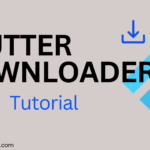Flutter is not only a popular framework for building mobile applications, but it also supports building high-performance web applications. Flutter Web enables you to create interactive, responsive web apps using the same codebase that you would use for iOS and Android apps. This post will provide an in-depth look at Flutter Web, including its setup, architecture, key features, advantages, and best practices. You will also learn how to build and deploy a simple Web application.
What is Flutter Web?
It is an extension of Flutter that allows developers to build and deploy web applications from a single codebase. With the same Flutter framework that is used for mobile app development, Flutter Web provides tools to create fast, responsive, and interactive web applications.
Key Features of Flutter Web:
- Single Codebase: Build for web, iOS, and Android using one codebase.
- Rich UI: Leverage Flutter’s expressive UI components, animations, and custom designs for the web.
- Fast Performance: Compile
Fluttercode to highly optimized JavaScript code for the web. - Responsive Design: Build responsive apps that adapt to different screen sizes and orientations.
- Hot Reload: Like in mobile Flutter, you can use hot reload for faster development iterations.
Setting Up Flutter for Web
Before you can build a web app with Flutter, you need to ensure your development environment is set up for it.
Steps to Set Up Flutter Web:
- Install Flutter: If you haven’t installed Flutter, you can download it from the official Flutter website.
- Enable Web Support: Ensure that web support is enabled by running:bashCopy code
flutter config --enable-web - Check Available Devices: Run the following command to see if the web device is available:bashCopy code
flutter devicesYou should seeChromeor another web browser listed as a target device. - Create a New Web Project: You can create a new
Flutterproject that supports web by running:bashCopy codeflutter create my_web_app - Run the App on Web: To run the app on the web, use the following command:bashCopy code
flutter run -d chrome
Once the app is running, it will open in your default browser, and you can start developing your web application.
Architecture of Flutter Web
Flutter Web uses a layered architecture that consists of the following key components:
- Flutter Framework: The Dart-based framework is the core that provides UI components, animations, and interactivity.
- Flutter Engine: The engine renders the UI using HTML, Canvas, and WebGL, converting the Dart code to JavaScript for the web.
- Web Platform: The web browser acts as the platform for running the
Flutter webapp.
Flutter Web compiles Dart code to JavaScript, which runs efficiently in any modern web browser. The framework provides UI widgets that automatically adapt to different screen sizes, making it ideal for building responsive web applications.
Building a Flutter Web Application
Building a Flutter Web app follows a similar process to building a mobile Flutter app, with minor differences in deployment and platform-specific considerations.
Example of a Simple Flutter Web Application:
import 'package:flutter/material.dart';
void main() {
runApp(MyWebApp());
}
class MyWebApp extends StatelessWidget {
@override
Widget build(BuildContext context) {
return MaterialApp(
title: 'Flutter Web Demo',
theme: ThemeData(primarySwatch: Colors.blue),
home: HomePage(),
);
}
}
class HomePage extends StatelessWidget {
@override
Widget build(BuildContext context) {
return Scaffold(
appBar: AppBar(title: Text('Flutter Web Home')),
body: Center(
child: Text(
'Welcome to Flutter Web!',
style: TextStyle(fontSize: 24),
),
),
);
}
}Explanation:
- MaterialApp: The
MaterialAppwidget provides the structure for the Flutter Web application, similar to how it works for mobile apps. - Scaffold: The
Scaffoldwidget defines the basic layout, including the app bar and body content. - Responsive UI: You can build responsive UIs by using
MediaQueryor Flutter’s built-in layout widgets likeExpanded,Flexible, andLayoutBuilder.
Responsive Design in Flutter Web
A critical aspect of building web applications is ensuring that the design is responsive and works well across different screen sizes and devices. Flutter Web provides tools to create flexible layouts that adjust to the available screen space.
Example of a Responsive Layout:
class ResponsiveHomePage extends StatelessWidget {
@override
Widget build(BuildContext context) {
return LayoutBuilder(
builder: (context, constraints) {
if (constraints.maxWidth > 600) {
return _buildWideScreenLayout();
} else {
return _buildNarrowScreenLayout();
}
},
);
}
Widget _buildWideScreenLayout() {
return Row(
children: [
Expanded(
child: Container(color: Colors.blue, child: Text('Wide Screen')),
),
Expanded(
child: Container(color: Colors.green, child: Text('Additional Content')),
),
],
);
}
Widget _buildNarrowScreenLayout() {
return Column(
children: [
Container(color: Colors.blue, child: Text('Narrow Screen')),
Container(color: Colors.green, child: Text('More Content')),
],
);
}
}Explanation:
- LayoutBuilder: This widget allows you to build different layouts depending on the screen size.
- Expanded and Column/Row: These widgets help create flexible layouts that adjust based on the available space.
Deployment of Flutter Web Application
Once your web application is ready, you can deploy it to any static web hosting service, such as GitHub Pages, Firebase Hosting, or your own server.
Steps to Deploy a Flutter Web App:
- Build the Web App: To build the web app for production, run the following command:bashCopy code
flutter build web - Locate Build Output: The compiled web app files will be available in the
build/webdirectory. - Deploy to Hosting Service: Upload the contents of the
build/webfolder to your web hosting service. For Firebase Hosting, you can use the Firebase CLI for an easy deployment process.
Best Practices for Flutter Web
- Use Responsive Layouts: Always design your Flutter Web apps to be responsive, ensuring they work well on both desktop and mobile browsers.
- Optimize Performance: Use the
buildmethod efficiently and avoid unnecessary rebuilds. Leverage Flutter’s performance tools to identify bottlenecks. - Test Across Browsers: Ensure that your app works across different web browsers, including Chrome, Firefox, Safari, and Edge.
- Use Web-Specific Features: Flutter Web allows you to interact with the browser’s APIs, such as URL navigation, local storage, and more.
Conclusion
Flutter expands possibilities for developers by enabling the creation of interactive, high-performance web applications using the same framework as for mobile. With rich UI components, responsive design capabilities, and efficient performance, it’s an excellent choice for building modern web apps. Understanding how to set up, build, and deploy a Flutter-based web app is essential for developers looking to expand their skills beyond mobile development.
Happy Coding…!!!














Leave a Reply